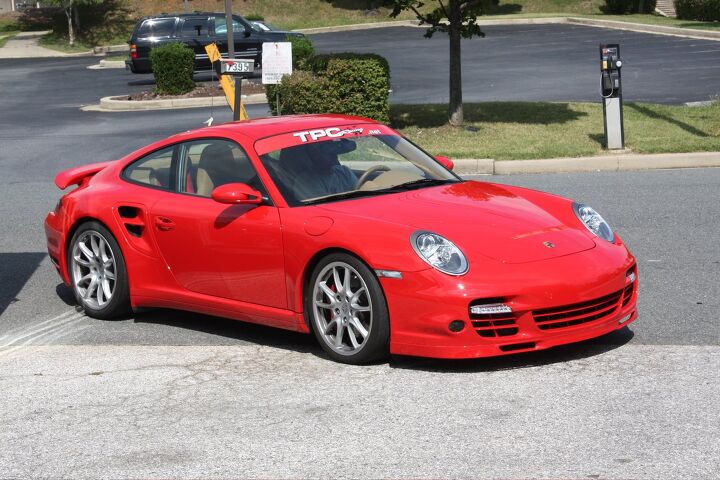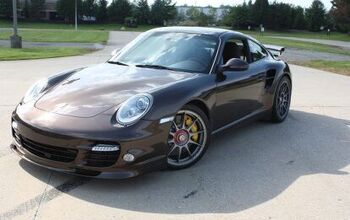Review: Porsche 997 Turbo By TPC

The fastest car I have ever driven is, without a doubt, the Switzer P800 variant of Porsche’s 911 GT2, as reviewed here. The folks at TPC have a roughly similar tuning package that retains the Porsche variable-geometry turbochargers, claimed to produce 775 horsepower and rather amusingly called the “775 Blitzkrieg”. This past September, I had the opportunity to take a ride with TPC’s founder Mike Levitas in the prototype Blitzkrieg. It’s awfully quick, if perhaps not quite as violently impressive as Switzer’s car. However, since TPC was unwilling to let us drive the Blitzkrieg, and since TTAC is unwilling to follow the lead of EVO, Top Gear, and pretty much every other print rag in the free world by writing-up a ride-along as a road test, that’s where we have to let the matter rest. It seems like a good car and if you have money to burn, give TPC a call to find out for yourself.
Luckily for us, TPC customer Joseph Lakowicz was on hand and he positively insisted that I drive his Meteor Grey 997 TT Tiptronic, tuned by TPC to produce approximately six hundred horsepower. Faced with this opportunity to pedal yet another ten-second car on the public roads, I did what any of TTAC’s readers would have done: I took the TPC Tip TT (that’s a mouthful) to visit my childhood home in Columbia, Maryland. I expected that we might be challenged at stoplights by machinery as diverse as the Toyota Highlander and Lexus RX350, and that we would smoke those mothers. This expectation was not entirely fulfilled, as you will see.
It’s been a while since I lived in the little house on Tower Top Court in Columbia’s Long Reach Village. In fact, it’s been more than twenty-six years. One might think that Porsche’s “PCM” navigation system would be capable of finding a three-decade-old home on the East Coast, but in the end Joe and I had to resort to using my BlackBerry’s Google Maps application. “I really don’t mess with the navigation… it doesn’t seem very good,” Joe opined, and he is correct. PCM is a mess and you could get better navigation in a twenty-grand Ford Fusion, or by selecting the very cheapest Garmin GPS at your local Best Buy.
Once the BlackBerry pointed us in the proper direction, however, we were able to head that way with nothing less than utter ferocity. This four-wheel-drive Turbo launches from a stoplight as if it were departing the USS Nimitz on the hook of a steam
catapult. Like all pre-PDK 997 Turbos, this is a five-speed, torque-converter gearbox without launch control, so one merely steps on the brake and dials up about 2500 rpm. Releasing the brake will chirp all four corners, flash the traction light, and render the traffic on both sides invisible.
Given that the Tiptronic offers a dilatory, uncooperative sort of steering-wheel manual control, one might be tempted to make one’s own shifts during these stoplight blasts. My second attempt at doing so caused the grey Turbo to select neutral instead of second gear, forcing me to coast to the side of the road as the aforementioned Highlanders and RX350s cruised triumphantly by. Nothing short of restarting the car would permit it to select a forward gear again. It turns out that the 997Turbo is too smart to let you grenade the transmission with excessive force during a shift, surely a reassurance to anybody contemplating pumping-up their own Porsche with this kind of thrust. Best to leave it in “D” and enjoy a completely no-hassle trip into the ten-second zone.
After more than 24,000 satisfactory miles, Joe swears by the concept of the Tiptronic Turbo. I’m not so sure, but there is some massive satisfaction to be had from driving something so disturbingly quick and yet so completely tractable. In the stop-and-go traffic that characterizes Columbia’s main roads, the TPC tune is utterly unnoticeable. This Turbo is as friendly as a Camry while crawling at five miles per hour, and if the navigation is garbage, the hand-sewn cocoa leather dashboard is first-rate enough to soften the annoyance.
Let a hole in traffic appear, no matter how slight, and the big Porsche rips through it with a slurred downshift and a lag-free punch in the back. It is quiet, tractable, and faster than a 997 Cup Car in a straight line. This on-road supremacy is the fulfilled promise of the 1974 Turbo Carrera model, made reality after thirty-some years. Track junkies and back-road blasters will find more satisfaction in a GT3 or — whisper it — a Cayman S. The stock Turbo suffers from being a little slower than a GT-R or Z06, but TPC neatly rectifies this problem at a price considerably below what Porsche would charge.
I arrived at my childhood home to find it much smaller, and much humbler, than I remembered. A quick check of recent real estate sales, however, showed that it was worth more than four hundred grand. This Turbo is similarly deceptive. Subtle to a fault, easy to drive, it can still do the business like almost nothing else. The child in me likes it, as does the adult.

More by Jack Baruth
Latest Car Reviews
Read moreLatest Product Reviews
Read moreRecent Comments
- Teddyc73 Oh look dull grey with black wheels. How original.
- Teddyc73 "Matte paint looks good on this car." No it doesn't. It doesn't look good on any car. From the Nissan Versa I rented all the up to this monstrosity. This paint trend needs to die before out roads are awash with grey vehicles with black wheels. Why are people such lemmings lacking in individuality? Come on people, embrace color.
- Flashindapan Will I miss the Malibu, no. Will I miss one less midsize sedan that’s comfortable, reliable and reasonably priced, yes.
- Theflyersfan I used to love the 7-series. One of those aspirational luxury cars. And then I parked right next to one of the new ones just over the weekend. And that love went away. Honestly, if this is what the Chinese market thinks is luxury, let them have it. Because, and I'll be reserved here, this is one butt-ugly, mutha f'n, unholy trainwreck of a design. There has to be an excellent car under all of the grotesque and overdone bodywork. What were they thinking? Luxury is a feeling. It's the soft leather seats. It's the solid door thunk. It's groundbreaking engineering (that hopefully holds up.) It's a presence that oozes "I have arrived," not screaming "LOOK AT ME EVERYONE!!!" The latter is the yahoo who just won $1,000,000 off of a scratch-off and blows it on extra chrome and a dozen light bars on a new F150. It isn't six feet of screens, a dozen suspension settings that don't feel right, and no steering feel. It also isn't a design that is going to be so dated looking in five years that no one is going to want to touch it. Didn't BMW learn anything from the Bangle-butt backlash of 2002?
- Theflyersfan Honda, Toyota, Nissan, Hyundai, and Kia still don't seem to have a problem moving sedans off of the lot. I also see more than a few new 3-series, C-classes and A4s as well showing the Germans can sell the expensive ones. Sales might be down compared to 10-15 years ago, but hundreds of thousands of sales in the US alone isn't anything to sneeze at. What we've had is the thinning of the herd. The crap sedans have exited stage left. And GM has let the Malibu sit and rot on the vine for so long that this was bound to happen. And it bears repeating - auto trends go in cycles. Many times the cars purchased by the next generation aren't the ones their parents and grandparents bought. Who's to say that in 10 years, CUVs are going to be seen at that generation's minivans and no one wants to touch them? The Japanese and Koreans will welcome those buyers back to their full lineups while GM, Ford, and whatever remains of what was Chrysler/Dodge will be back in front of Congress pleading poverty.








































Comments
Join the conversation
JB: "0-60 times don’t mean much to me. I’d rather see quarter-mile or 0-150 times. With cars of this power level, 0-60 is a straight metric of available traction." Ditto, JB. Published acceleration tests show that the 650+hp tuners' cars are barely (if at all) quicker to 125 mph, but pull away convincingly beyond that. The remarkable achievement of the PDK Turbo is to get to 125 mph just about 1 sec. or less behind the tuner cars, with apparently no special driver skills required, with 100-300 hp less. At stop lights, I would expect the PDK Turbo to frequently outgun the tuner cars, due simply to the high degree of driver skill needed to launch the tuner cars effectively. The finely matched gearing and power curve of the Turbo, plus the launch control and extremely quick shifting, truly optimize all the performance factors for a superb result. However, as noted above, the factory car falls behind beyond 125 mph. Clever product packaging by Porsche. After all, how often can you nowadays find situations where you can drive much beyond 125 mph, even on the autobahn?